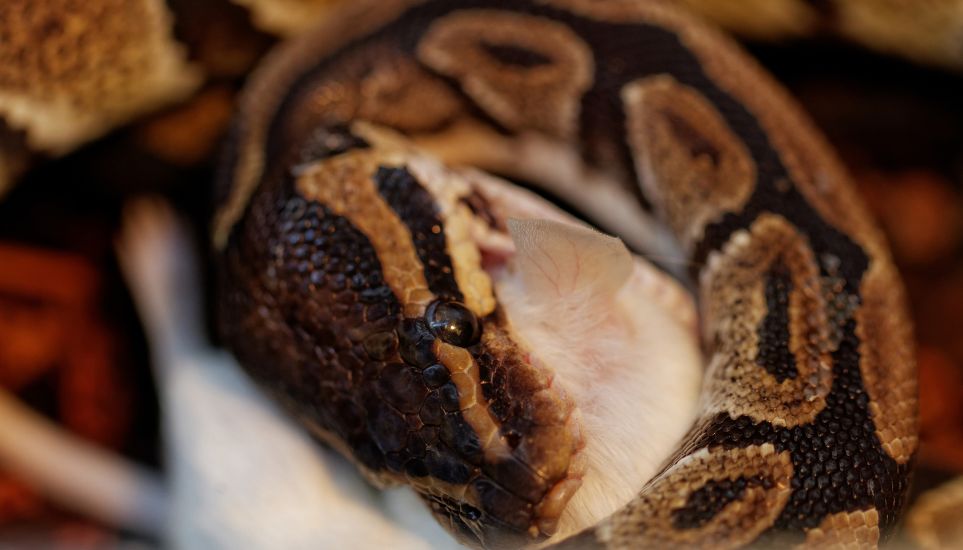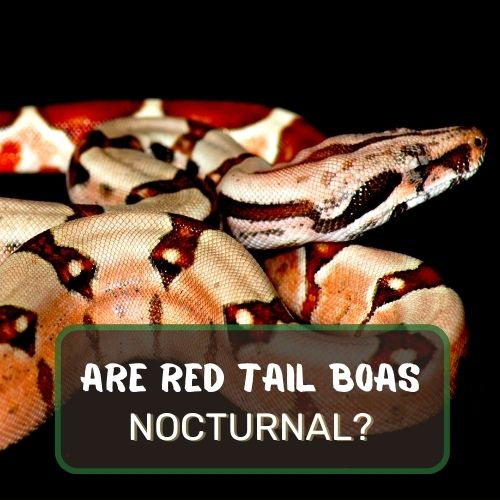Ready to dive into the intriguing world of red tail boas and their eating habits? You’re in for a treat!
Red tail boas are generally not picky eaters in the wild, where they’re opportunistic hunters. However, once in captivity, their eating habits can change. Some may become choosy, even refusing meals occasionally.
This shift might not always be about the food; factors like environmental conditions and boredom can also play a part. So, are they picky eaters?
It’s complicated.
Their “pickiness” could be situational and may require some detective work to figure out.
In this comprehensive article, we’ll explore everything from their natural diet in the wild to the changes that happen when they’re in captivity.
We’ll also delve into the nutritional building blocks that keep them healthy, how often they really need to eat, and the signs that might indicate you’ve got a picky eater on your hands.
Buckle up, because we’re going on a culinary journey through the life of a red tail boa!

Table of Contents
- 1 What Makes Up a Red Tail Boa’s Diet in the Wild?
- 2 A Look Into Captivity: How Does Diet Change?
- 3 Nutritional Needs: The Building Blocks of a Healthy Red Tail Boa
- 4 Feeding Frequency: How Often Should They Eat?
- 5 Signs of a Picky Eater: What to Look Out For
- 6 Overcoming Picky Eating: Tips and Tricks
- 7 Conclusion
- 8 FAQ
What Makes Up a Red Tail Boa’s Diet in the Wild?
The Menu in Mother Nature’s Kitchen
So, you’re itching to know what red tail boas munch on when they’re out and about in the wild, huh? Let me lay it down for you. In nature, these slinky creatures are opportunistic feeders.
To put it simply, they’re not turning up their noses at much. Small mammals like rats and mice are top of the menu, and occasionally they’ll go for a bird if it catches their fancy.
The Art of Ambush Hunting
How do they snag these meals? Ambush hunting is their go-to style. Imagine this: a red tail boa finds a comfy hiding spot and then sits back, taking in the sights and sounds while waiting for dinner to pass by.
When the moment’s just right, they spring into action, constricting their prey with their muscle-packed bodies. It’s the equivalent of a workout and a meal, all in one!
Picky Eaters or Survivors?
So, are red tail boas picky eaters in their natural habitat? Not a chance. When it comes to survival, these reptiles are pretty much down for whatever’s available. They’re more into the ‘eat to live’ philosophy than having a refined palate.
A Look Into Captivity: How Does Diet Change?
The Room Service Lifestyle
Alright, now let’s pivot to captivity. What happens when a red tail boa swaps the great outdoors for the snug life of a controlled environment?
Well, things change.
Their diet becomes a lot more “room service” than “hunt it yourself.” This usually means a menu full of pre-killed rodents, like mice and rats.
The Rise of the Fussy Eater
But here’s the kicker. Once they’re in captivity, some red tail boas start getting a bit, let’s say, particular about what they eat. Yup, a smidge of fussiness can set in. Sometimes they even go on a food strike. And this is where folks start wondering if they’ve turned into picky eaters.
The Expert’s Take
What’s the word from the experts? Well, this newfound “pickiness” might be about more than just the food. Lack of exercise, boredom from a monotonous diet—these factors can also influence their eating habits.
So, in captivity, the question of “Are red tail boas picky eaters?” gets a bit more layered. It’s not a simple yes or no.
Nutritional Needs: The Building Blocks of a Healthy Red Tail Boa
The Importance of a Balanced Diet
Alright, we’re switching gears to nutrition, the building blocks of a thriving red tail boa. Just like you wouldn’t thrive on a diet of pizza and soda alone (tempting as it may be), these reptiles need a well-rounded nutritional plan. And hey, it’s not just about shoving a mouse their way and calling it a day!
Protein: The Main Attraction
The big kahuna in a red tail boa’s diet is protein. Think of it as the steak in their three-course meal, the main act, the headline band! Protein fuels their muscle growth and general health, so it’s a non-negotiable.
Vitamins and Minerals: The Supporting Cast
While protein may be the star, vitamins and minerals are the crucial supporting cast. Calcium and vitamin D are especially important for strong bones and overall well-being.
Some folks even go the extra mile and offer supplements to ensure their slithering friends are getting all the nutrients they need.
The Consequences of a Poor Diet
Now, what happens when you drop the ball on nutrition? Well, bad news bears—poor diet can lead to all sorts of issues like lethargy, growth problems, and even severe health conditions. Yes, folks, diet matters!
A Word on Hydration
And let’s not forget water! Hydration is as important for these creatures as it is for us. A constant supply of clean, fresh water is crucial to keep them in tip-top shape.
Feeding Frequency: How Often Should They Eat?
Age and Size Matter
If you’re wondering how often to roll out the red carpet for dinner time, let me tell you—it depends. Younger red tail boas, being the growing youngsters they are, usually need to eat more frequently, think once a week. Adult boas? They’re cool with a meal every two to four weeks.
Seasonal Variations
Hold up! Did you know that the time of year can also affect their appetite? During the winter months, some boas go off their feed. It’s not them being fussy; it’s just their natural response to the cooler temps.
Food Refusal: When Should You Worry?
One more thing. Every so often, a red tail boa might turn down a meal. Don’t hit the panic button just yet. It could be due to a variety of reasons—stress, upcoming shedding, or even just not feeling it that day. But if it becomes a pattern, you might want to consult the experts.
Signs of a Picky Eater: What to Look Out For
Food Refusal: The Obvious Sign
So, you’ve noticed your red tail boa hasn’t been too keen on mealtime lately? If they’re turning down those carefully selected rats or mice, it’s the most obvious sign you’ve got a picky eater on your hands.
Change in Behavior: The Subtle Clues
But hey, let’s not jump to conclusions just based on one missed meal. Keep an eye out for changes in behavior. Are they less active than usual? Do they seem disinterested when it’s feeding time? Those could be your subtle clues.
Seasonal Changes: Don’t Get Fooled
Remember, these guys might have natural fluctuations in appetite depending on the season. If it’s winter and your boa is not eating, it might just be their natural rhythm rather than a case of being fussy.
Frequent Hide and Seek
Another sign could be your boa spending more time hiding. It’s like they’re avoiding the dinner table! If you notice these signs, it’s time to put on your detective hat and find out what’s going on.
Overcoming Picky Eating: Tips and Tricks
Switch it Up: Variety is the Spice of Life
Alright, so you’ve established you’ve got a picky eater. Now what? One of the first things you can try is offering a variety of prey. Maybe your boa is bored with mice and wants to try a rat or even a small bird. A little culinary diversity can go a long way!
Check the Environment: Comfort is Key
Before blaming your boa’s selective eating on their tastes, double-check the environment. Is the temperature right? Is their enclosure comfortable? These factors can greatly affect their willingness to eat.
Warm the Food: Make it More Appealing
You can also try warming the prey a bit to make it more appetizing. This mimics the body heat of live prey and could make the meal more enticing to a skeptical boa.
When to Seek Expert Advice
If you’ve tried all these tricks and your boa is still refusing meals, it’s time to consult an expert. There might be underlying health issues that require professional attention. Trust me, when it comes to the health and happiness of your scaly friend, you don’t want to take any chances.
Conclusion
You’ve journeyed through the fascinating world of red tail boas, exploring their dietary habits in both wild and captive settings.
You’ve also gained insights into their nutritional needs, feeding frequency, and even how to deal with picky eating behavior.
Remember, understanding your red tail boa’s dietary preferences is crucial for its well-being. Whether your boa is a voracious eater or a little on the finicky side, the key lies in attention to detail and a willingness to adapt.
You’re well on your way to becoming not just a pet owner, but a responsible and well-informed boa connoisseur. Keep up the good work!
FAQ
Why is my boa refusing to eat?
Great question! A boa might refuse to eat for various reasons. Stress, temperature changes, and impending shedding could all be culprits. It’s also worth considering that they could be naturally less hungry during the winter. And hey, if it’s a consistent issue, consult a vet.
How often does a red tail boa need to eat?
Well, that depends on their age and size. Juvenile boas usually require a meal once a week. Adult boas can chill out a bit, needing a meal every two to four weeks. Just don’t forget, winter could be a fasting period for some!
How do you get a red tail boa to eat?
Ah, the million-dollar question! If your red tail boa is being a picky eater, try varying their diet or warming the prey to mimic live food. Ensuring a comfortable and stress-free environment can also make a huge difference.
How long can boas go without eating?
Boas are pretty resilient. Adult boas can go for a few months without food if needed, although it’s not advisable. Younger boas shouldn’t go for more than a week or two without eating, as they’re still growing.
What is a boa constrictor’s favorite food?
In the wild, red tail boas love small mammals like rats and mice, and occasionally, they’ll go for a bird. In captivity, they’re usually fed pre-killed rats or mice. But remember, variety is key! So maybe introduce something new now and then.




0 Comments